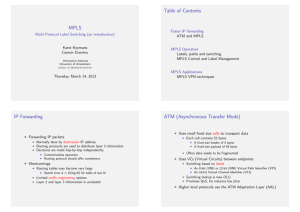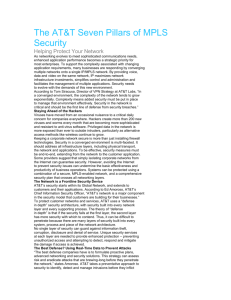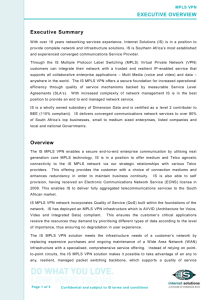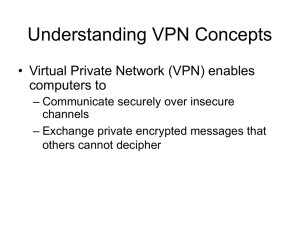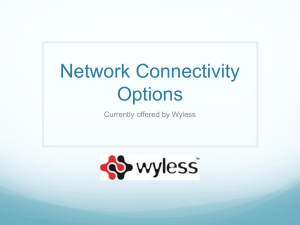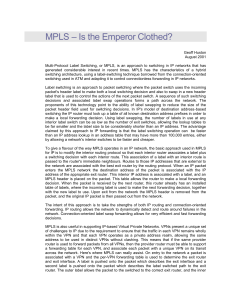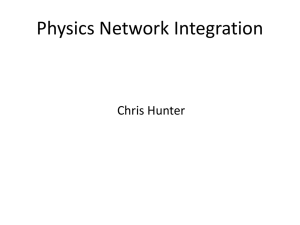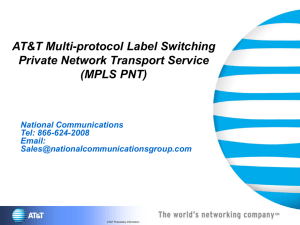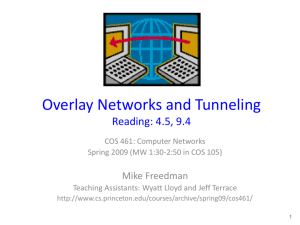Document
advertisement
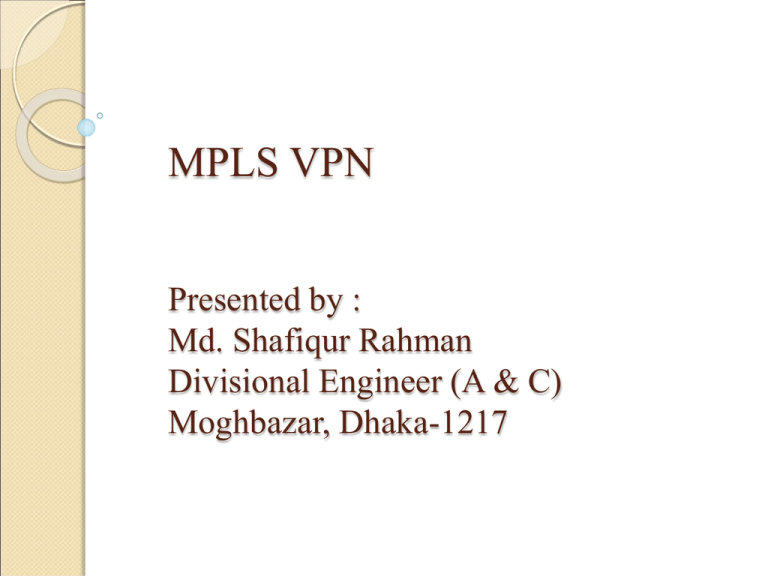
MPLS VPN Presented by : Md. Shafiqur Rahman Divisional Engineer (A & C) Moghbazar, Dhaka-1217 MPLS VPN Multi-Protocol Label Switching (MPLS) : Provides a mechanism for forwarding packets for any network protocol. Unlike traditional IP, MPLS flows are connectionoriented and packets are routed along pre-configured Label Switched Paths (LSPs). MPLS directs and carries data from one network node to the next MPLS is operable between the Data Link Layer and the Network Layer. MPLS VPN: (P2P VPN) Virtual Private Network (VPN) : A Data network that utilizes a portion of a shared public network to extend a customer’s private network. VPN use cryptographic tunnelling protocols to provide high level security; Important for any organizations that have many offices at different locations. Why? To expand their networking capabilities To secure their traffic To reduce their cost MPLS VPN: (P2P VPN) VPN Components : Customer network CE Router Provider network PE Router P Router Layer 2 MPLS VPN How Does it Work? MPLS-based Layer 2 VPNs prepends a label to a Layer 2 PDU and then forwarding the packet across the MPLS backbone. Provider (P) routers not be aware of the VPNs. They will continue to forward packets over pre-established lSPs. CE Routers will operate without any knowledge of the existence of MPLS VPNs. PE Routers do not participate in the routing algorithms of the end-users, and there no requirements for the construction of VPN routing and forwarding tables (VRFs) Contd… MPLS VPN How Does it Work? A different label is used for each hop, and it is chosen by the router or switch performing the forwarding operation. Ingress routers at the edge of the MPLS network classify each packet potentially using a range of attributes, not just the packet's destination ddress, to determine which LSP to use. Inside the network, the MPLS routers use only the LSP labels to forward the packet to the egress router. Contd…... MPLS VPN How Does it Work? An LSP acts as a tunnel carrying multiple VCs VCs are uni-directional, for bi-directional communication, a pair of VCs – one in each direction –is needed. Tunnel LSPs between the PE routers could be created using any protocol like RSVP/TE or LDP PE routers exchange the VC labels via LDP The PE router encapsulates the subscriber layer- 2 frame and attaches two labels ( top & inner) The receiving PE router pops the tunnel label and use the inner label to deliver the packet to the correct end-user. MPLS VPN How Does it Work? Customer frames are switched based on their destination MAC address. VPN is established by creating a full mesh of VCs between the PEs facing the sites that make the VPN. A PE router maintains a separate layer-2 forwarding table, Virtual Forwarding Instance (VFI), for each VPN that it carries. A PE router learns MAC addresses related only to the VPNs that it carries. A P router does not learn any MAC addtreeses, they just perform label switching. LSR (Label Switched Router) A uses the destination IP address on each packet to select the LSP which determines the next hop and initial label for each packet (21 and 17). When LSR B receives the packets, it uses these labels to identify the LSPs, from which it determines the next hops (LSRs D and C) and labels (47 and 11). The egress routers (LSRs D and C) strip off the final label and route the packet out of the network. P2P VPN Clients Existing Clients DGFI BDCOM Online Limited Drik Alokchitra Granthagar Ltd Aamra Networks Limited (30 Mbps) Always on Network (BD) Ltd Department of Immigration and Passport (155 Mbps) Potential Customers: o Govt. Organizations, Banks, NGOs, Insurance Companies, Educational Institutions, Groups of Companies, Police, RAB, ARMY, Chain shop,s Hospitals, Pharmaceuitical companies P2P VPN Service Limitations: Access Network Work Force Operational Engineers Coordination among different wings Weak marketing Slow decision making process Not less than 2 Mbps P2P VPN Service Recommendation: Immediate deployment of OFC as access network Developing skilled operational engineers more in numbers Development of Field lvevl Work Force in all service areas of BTCL Prompt Coordination among different wings Development of partnerships with third parties for ensuring yes to all and making decisions right the very moment Provisioning for less than 2 Mbps Why P2P VPN Saleable? Dhaka- CTG: 2 MBPS DDN Data Connectivty Cost: OTC= Tk. 11,000, YRC= TK. 11,55,000 2 Mbps P2P VPN Data Connectivity Cost: OTC=Tk. 15,000, YRC= TK2,55,000 ( 22% of DDN Cost) PoP is almost everywhere around the clients. P2P VPN Charge Calculations Components of Charges: NRC (OTC): Non-recurring Charging Registration Charge: TK. 5,000 Installation Charges: E1 or 2 Mbps: TK. 10,000 DS3 : TK. 70,000 STM-1 : TK. 1,40,000 4xSTM-1 : TK. 4,00,000 STM-4 : TK. 3,00,000 (x2.5) STM-16 : TK. 10.00,000 (x 9) STM-64 : TK. 20,00,000 (x18) Price Multiplication Factor: 1E1-3E1: 1; 4E1-20E1: 0.7, 21E1-41E1: 0,42; 42E1-62E1:0,3, 63E1/STM1: 0.17 P2P VPN Charges Components of Charges: MRC: Monthly Recurring Charging ( Based on E1 Capacity: 30% discount for VPN) Row Slab in Km Monthly Charge Tk./E1/Km Comment 1 0-25 - Tk. 4,000 (Fixed)/Month 2 26-50 165 Cumulative 3 51-100 140 Cumulative 4 101-200 105 Cumulative 5 201-300 63 Cumulative 6 301- 21 Cumulative P2P VPN Charges Components of Charges: Discounting Parties: Type of Subscriber Discount IIG Operator/NIX Operator 65% Call centre/ Software Exports / BPO/ Medical Transcription Service/ IT Enabled Service Provider/ Public Educational Institutions/ Internet Service Provider 60% Government/ Semi-Government/ Autonomous/ Corporations/Statutory Body/ Govt. Company 30% PSTN/PLMN/ITC Operator/ Non Govt. Bank/ Private Educational Institutions 10% THANK YOU



